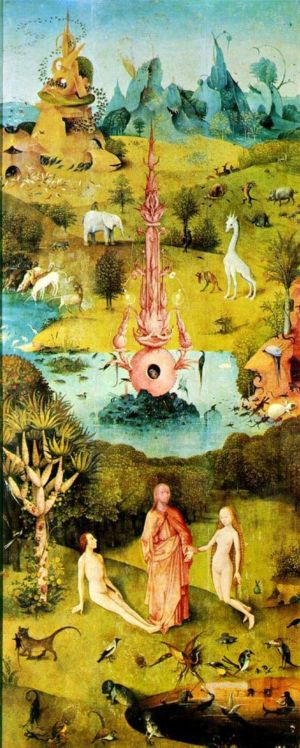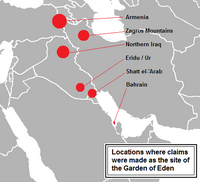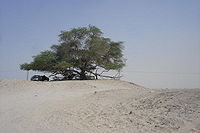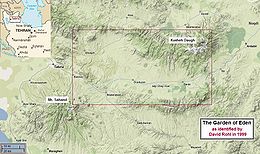Garden Of Eden
 From Conservapedia
From Conservapedia The Garden of Eden (Hebrew: גַּן עֵדֶן `edhen; "delight") was the dwelling place for the first two humans God created - Adam and Eve - according to the biblical book of Genesis. The Garden was a paradise of infinite happiness where Adam and Eve would never suffer any scarcity, illness or death. However, Adam and Eve defied the will of God by eating the forbidden fruit (the fruit of the Tree of the Knowledge of Good and Evil) at the center of the Garden, and God cast them out of the Garden so that they would no longer live forever. Genesis says that a cherub (angel) with a flaming sword then guarded the Garden of Eden to prevent humans from returning. The meaning of the word "paradise" is the Garden of Eden ("παράδεισος" or paradeisos in Greek).
The Garden of Eden has inspired great literature:
- Shakespeare's Hamlet, perhaps the greatest play ever, imitates the temptation and fall in the Garden of Eden.[1]
- the famous novel and movie East of Eden, by John Steinbeck and starring James Dean, is named after the banishment of Cain eastward from the Garden of Eden.
- a point-of-reference for many additional novels, television shows, and movies, such as This Side of Paradise and an episode of Star Trek by the same name.[2]
Contents
Description[edit]
Genesis describes the Garden as being "in the east, in Eden" (Gen 2:8). In the Assyrian inscriptions idinu (Accadian: edin) means "plain" and it is from this that the Biblical word is probably derived. The Garden is described as having "all kinds" of trees growing in it, and two are specifically named: the Tree of Life, and the Tree of the Knowledge of Good and Evil, the latter being in the center of the Garden (Gen 2:9). It was from this tree that Adam was told that he was forbidden to eat from (Gen 2:17). The vegetation was luxurious (Gen 2:9) and the fig tree indigenous (Gen 3:7), and where it was watered by four rivers which flowed from Eden:
- And a river went out of Eden to water the garden; and from thence it was parted, and became into four heads.
- The name of the first is Pison: that is it which compasseth the whole land of Havilah, where there is gold;
- And the gold of that land is good: there is bdellium and the onyx stone.
- And the name of the second river is Gihon: the same is it that compasseth the whole land of Ethiopia.
- And the name of the third river is Hiddekel: that is it which goeth toward the east of Assyria. And the fourth river is Euphrates.
- (Genesis 2:10-14; King James Version)
Biblical scholars have determined the last two rivers mentioned to be the existing Tigris and Euphrates rivers, which have their headwaters in the Zagros Mountains of Iran; the other two - the Pison and Gihon rivers - were more problematic.
All kinds of animals, including cattle, beasts of the field and birds, were found there (Gen 2:19,20). Moreover, the climate was such that clothing was not needed for warmth. It is not surprising, therefore, that the plural of the word has the meaning "delights," and that Eden has been supposed to mean the land of delights, and that the word became a synonym for Paradise.
Other Locations[edit]
As with many passages in Genesis, there is debate among Christians whether or not the story of the Garden of Eden should be taken literally or metaphorically. If taken literally, there is debate over its location, whether in the area of eastern Turkey/northern Iran, in southern Iraq, or elsewhere in the world.
In Dante's Divine Comedy, the Garden of Eden (or Earthly Paradise) is situated at the top of the Mountain of Purgatory in the southern hemisphere, where we now know Antarctica to be. Those who have been through Purgatory pass through the tranquil garden before they enter Heaven.
Central Asia[edit]
During his explorations to the South American mainland Christopher Columbus made the assumption that the Orinoco River was fed by waters which came down from the Garden of Eden, despite his own thoughts that he had found the eastern coast of the Asian continent. The traditions of its location somewhere in central Asia are numerous and persistent, and naturalists have in the past pretty generally fixed upon the portion of Central Asia stretching east from the Himalayas - often referred to as the roof of the world and from which flow four great rivers: the Indus, the Tarim, the Sur Daria (Jaxartes), and the Ainu Daria (Oxus) - as the original cradle of mankind. Usually, explanations for the central Asia hypothesis involve a touch of racial superiority, i.e. mankind's ancestors were of Aryan stock. Professor S.H. Buchanan, a Biblical scholar during the late 19th century, was one of those believers, who put down in his work The World and the Book:
- “Thus everything invites us to place the Eden of the Semites (Aryans) in the mountains of Belurtag, at the point where this chain unites with the Himalaya, toward the Plateau of Pamir... We are conducted to the same point, according to Brunoff, by the most ancient and authentic texts of the Zend-Avesta. The Hindu traditions also contained in the Mahabbarata and the Puranas, converge to the same region. There is the true Meru (Ararat) (of the Hindus), the true Albordj (of the Persians), the true river Arvanda, from which all rivers take their source, according to Persian tradition. There, according to the opinions of almost all the populations of Asia, is the central point of the world, the umbilici, the gate of the universe. There is the Uttarakura; ‘the country of happiness,’ of which Magesthanes writes. There is, finally the point of common attachment of the primitive geography, both of the Semitic and the Indo-European races.” [1]
The Jewish historian Flavius Josephus also hinted that the Garden of Eden had a central Asian location, having written down that the land was "watered by one river, which ran around the whole earth, and was parted into four parts, and Phison, which denotes a Multitude, running from India, makes its exit into the sea, and is by the Greeks called Ganges. Euphrates also, as well as Tigris, goes into the Red Sea... and Geon runs through Egypt, and denotes what arises from the East, which the Greeks call Nile." (Antiquities of the Jews, Book I:I:3.)
North Pole[edit]
Also as the 19th century ended Dr. William F. Warren created a theory which attempted to prove that Eden was located near the North Pole. What was in support of his theory was evidence in the fossil and geological records of several lands north of the Arctic Circle of a warm climate. However, as later discoveries were to prove, the North Pole was merely an ocean overlaid with an icecap, the nearest land hundreds of miles away. [2]
Mesopotamia and the Persian Gulf[edit]
Two theories locate Eden in the Euphrates valley. Of these the first place it near the head of the Persian Gulf where the Tigris and Euphrates rivers meet in the junction called the Shatt el-'Arab waterway, which once formed a point of conflict between Iraq and Iran. Recent authorities suggest that Gihon and Pishon are represented by the Karum and the Kerkhah rivers which come into the Shatt el-'Arab from the east. The most plausible objection to this theory is that the Biblical account represents all these branches as down stream from the main river, whereas this theory supposes that two of them at least are up stream. This objection has been ingeniously met by calling attention to the fact that 2,000 years before Christ the Persian Gulf extended up as far as Eridu, 100 miles above the present mouth of the river, and that the Tigris and the Euphrates then entered the head of the Gulf through separate channels, with the enormous amount of silt brought down by the streams during the centuries since havinf created the dry land which exists today. In consequence of the tides which extend up to the head of the Gulf, the current of all these streams would be turned up stream periodically, and so account for the Biblical statement. In this case the river (nahar) would be represented by the Persian Gulf itself, which was once called by the Babylonians nar marratum, "the bitter river." This theory is further supported by the fact that according to the cuneiform inscriptions Eridu was reputed to have in its neighborhood a garden, "a holy place," in which there grew a sacred palm tree. This "tree of life" appears frequently upon the inscriptions with two guardian spirits standing on either side.
The other theory, postulated by Friedrich Delitzsch, places Eden just above the site of ancient Babylon, where the Tigris and Euphrates approach to within a short distance of one another and where the country is intersected by numerous irrigating streams which put off from the Euphrates and flow into the Tigris, whose level is here considerably lower than that of the Euphrates. Delitzsch assumed the Shatt el-Nil, which flows eastward into the Tigris, to be the Gihon, and the Pallacopas, flowing on the West side of the Euphrates through a region producing gold, to be the Pishon. The chief difficulties attending this theory pertain to the identification of the Pishon with the Pallacopas, and the location of Havilah on its banks. The difficulty in these theories is the identification of Cush (Ethiopia), later associated with the country on the horn of Africa, thus giving countenance to the belief of Josephus and many others that that river represented the Gihon.
In the island nation of Bahrain stands the Shajarat al-Hayah, the Tree of Life. A major tourist attraction in the smallest Arab country, this tree stands alone in the middle of a desert with no known source of water feeding it, and comparrisons to the tree of Eden have been made. [3][4]
David Rohl[edit]
British archaeologist and anthropologist David Rohl claimed to have found the precise location of the Garden of Eden after over a decade of studying ancient documents, including the Sumerian tablets held at the Museum of the Orient in Istanbul, Turkey. His conclusion is that the location conforms to an area northwest of Teheran, Iran, in a valley watered by a small river in which the locals call Adji Chay ("walled garden"); indeed, the entire valley is surrounded by mountains, with the dormant volcano Mt. Sahand sutuated on the southwest corner. On the northside of the valley rises Kusheh Daugh (mountain of Kush), which Rohl claims to be the source for the "land of Cush" (i.e. Ethiopia) of the Genesis account.
To help establish this belief, Rohl turned to an ancient source, the Sumerian cuneiform epic Enmerkar and the Lord of Aratta, which was written possibly 5,000 years ago by an emissary of the Sumerian priest-king of Uruk [5]. Gold and lapus lazuli were needed to build a temple, and an emissary was dispatched to Aratta "on the plain of Edin" - as the Sumerians referred to the area - to retrieve them. The two rivers scholars had a problem with - the Pison and Gihon - were identified with the Araxes and Uizhun rivers, which puts the headwaters of all four rivers into his Eden. Further, Rohl's equivalent to the Pishon - the Araxes - which the Bible identifies with gold, flows between ancient cold and lapus lazuli mines, and is known locally as the Golden River.
To strengthen his claim, Rohl identified the area to the east of his Eden valley as the "land of Nod", to which Cain fled to after he killed his brother Abel (Gen 4:1-16)[6]; the locals call it "Noqdi" today.
References[edit]
- ↑ https://www.bartleby.com/essay/Hamlet-And-The-Garden-Of-Eden-FJEYNJFW9X6
- ↑ https://www.theviewscreen.com/this-side-of-paradise/
| ||||||||||||||
Categories: [Ancient History] [Biblical Places]
↧ Download as ZWI file | Last modified: 02/19/2023 10:23:45 | 15 views
☰ Source: https://www.conservapedia.com/Garden_of_Eden | License: CC BY-SA 3.0
 ZWI signed:
ZWI signed:




 KSF
KSF